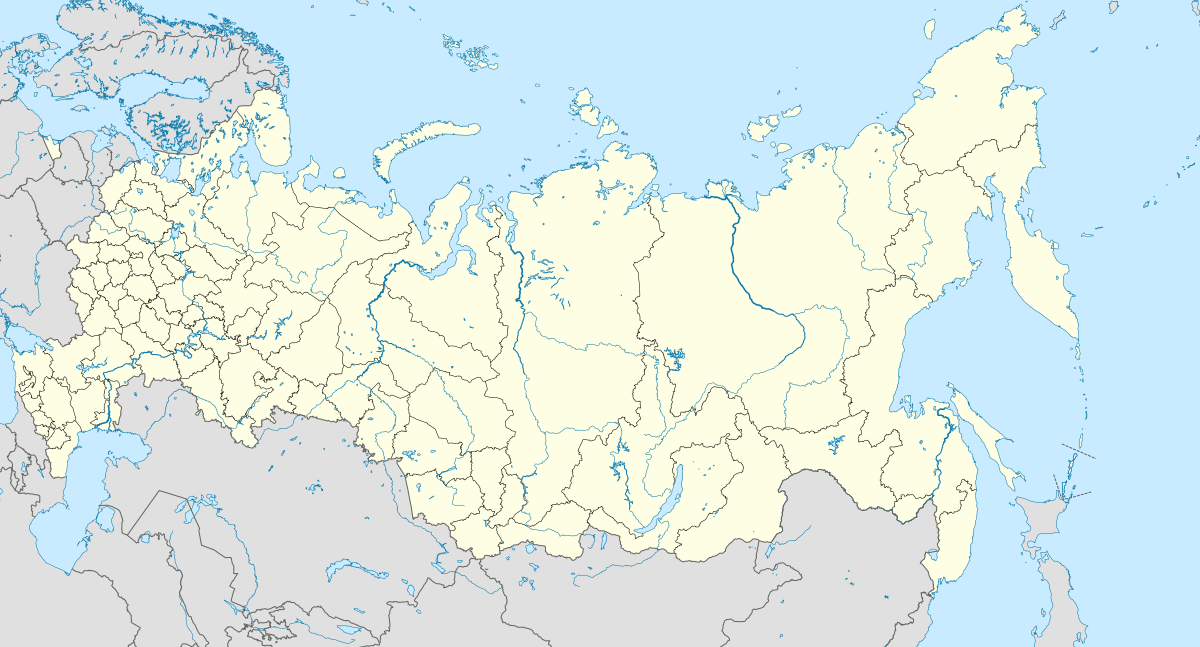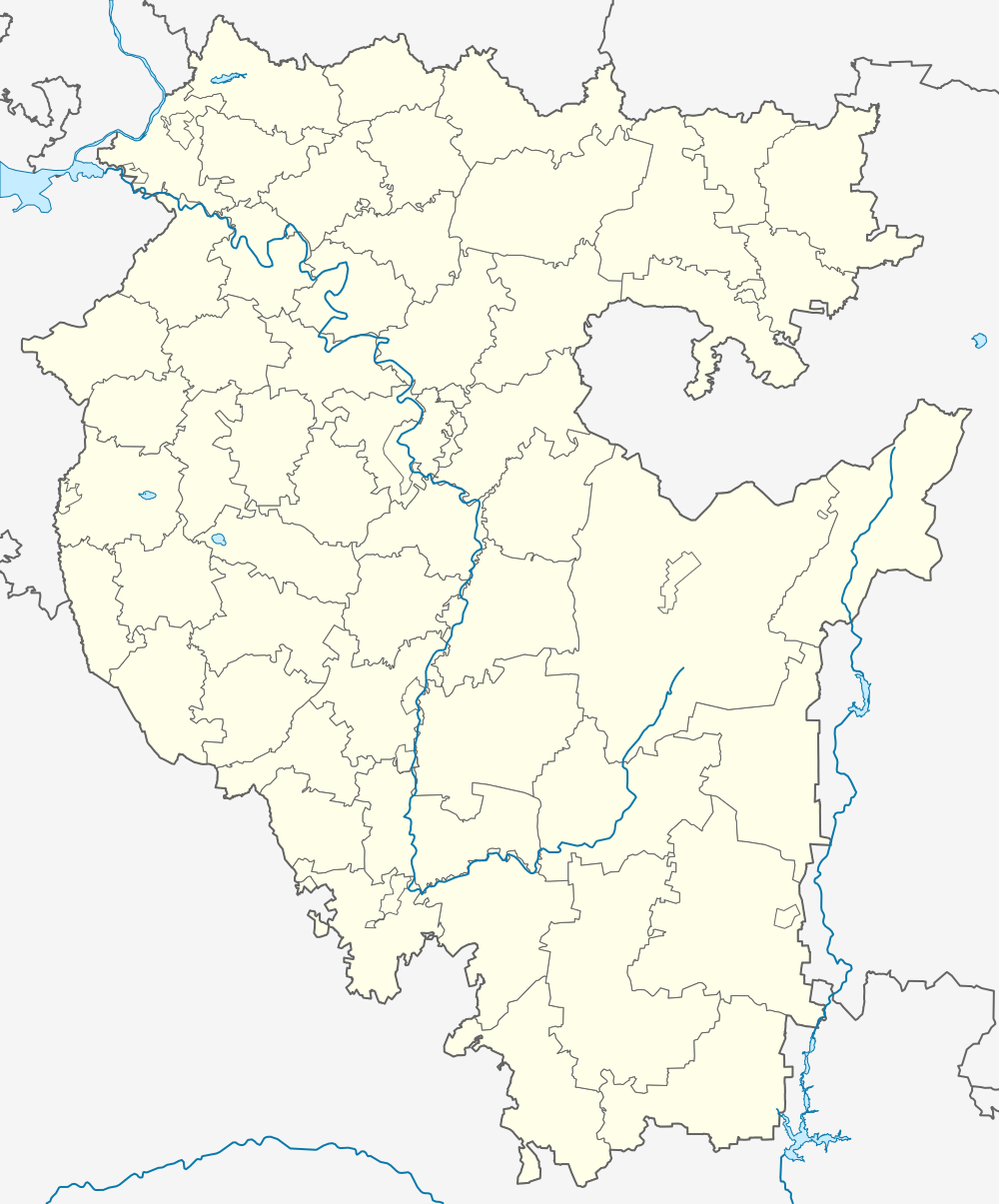Beloretsk
Beloretsk (Russian: Белоре́цк; Bashkir: Белорет) is a town in the Republic of Bashkortostan, Russia, located on the Belaya River, 245 kilometers (152 mi) from Ufa. Population: 68,806 (2010 Census);[2] 71,093 (2002 Census);[8] 72,434 (1989 Census).[9]
Beloretsk Белорецк | |
|---|---|
Town[1] | |
| Other transcription(s) | |
| • Bashkir | Белорет |
 Beloretsk water tower | |
 Flag .png) Coat of arms | |
Location of Beloretsk 
| |
 Beloretsk Location of Beloretsk  Beloretsk Beloretsk (Bashkortostan) | |
| Coordinates: 53°58′N 58°24′E | |
| Country | Russia |
| Federal subject | Bashkortostan[1] |
| Founded | 1762 |
| Town status since | 1923 |
| Elevation | 500 m (1,600 ft) |
| Population | |
| • Total | 68,806 |
| • Estimate (2018)[3] | 65,477 (-4.8%) |
| • Subordinated to | town of republic significance of Beloretsk[1] |
| • Capital of | Beloretsky District[4], town of republic significance of Beloretsk[1] |
| • Municipal district | Beloretsky Municipal District[5] |
| • Urban settlement | Beloretsk Urban Settlement[5] |
| • Capital of | Beloretsky Municipal District[5], Beloretsk Urban Settlement[5] |
| Time zone | UTC+5 (MSK+2 |
| Postal code(s)[7] | 453500 |
| OKTMO ID | 80611101001 |
History
Town-factories were a peculiar phenomenon in the town-planning in Russia in the 18th and 19th centuries. Beloretsk Iron Factory was built in 1762-1767 by merchants I. B. Tverdyshev and I. S. Myasnikov, who bought 170,041 desiatinas of land from Bashkirs of Belokatayskaya Volost.[10] Builders and first workers of the factory were purchased serfs from Kazan, Nizhny Novgorod, Penza, and Ryazan Governorates. Beloretsk itself was founded as a factory settlement in 1762.
A Bulletin of 1776 says that the Beloretsk Iron Factory was built in 1762 and had two blast furnaces and fourteen sledge-hammers. However, the first fusion of cast iron was recorded as being done in 1767. In 1777, the factory produced more iron than any other factory in Russia. Productive capacity of the factory was 122,500 poods (~2,000 metric tons) of cast iron and 80,000 poods (~1,300 metric tons) of iron per year. There were 840 male workers at the factory.
The village of Lomovka was founded in the vicinity of Beloretsk. The name of the village came from the name of the profession of the people who lived there. They all were draymen who supplied raw materials for the factory. Factory peasants also lived in the village of Arskaya, situated 8 miles (13 km) from their work place.
One of the memorable events in the history of Beloretsk was the participation of the factory workers in the 1773-1774 rebellion under the leadership of Yemelyan Pugachev. In 1774, rebel peasants took the factory by storm and reduced it to ashes to prevent recommencement work there. The villages of Lomovka and Arskaya were also burned down. The factory was inactive for three years after that.
In 1784, Beloretsk Iron Factory was inherited by D. I. Pashkova, who in 1803 started construction of the Tirlyan Iron Factory (Tirlyan was a village 30 kilometers (19 mi) away from Beloretsk).
In the beginning of the 19th century, Beloretsk Iron Factory had two blast-furnaces and eleven Catalan forges. The factory achieved much success in the production of metal. Cast iron produced by the factory was the cheapest in the South Urals and the iron produced was known for its ductility in the cold state. In 1874, the firm "Vogau and Co." became the new owner of the factory. By the end of the 19th century, the factory received the highest award at the Russian Countrywide Exhibition at Nizhny Novgorod.
By the end of the 19th century the population of Beloretsk was 15,000. At the time, Beloretsk was a part of Orenburg Governorate. Factory workers were active participants of the revolutionary movement in the South Urals. In 1917, Beloretsk became a part of the Bashkir ASSR.
In July 1918, the Beloretsk Socialistic Regiment was formed consisting of the factory workers. The Regiment formed a part of the Urals Partisan Army under the command of Vasily Blyukher and performed a raid against the White Guard.
In 1923, Beloretsk was granted town status. By then, the population of the town, including the villages of Tirlyan and Lomovka, was 28,830. In 1930, Beloretsky District was established. At the same time, modernization of the Beloretsk Factory was started. In 1940, Beloretsk Cast Iron Melting Factory, Beloretsk Iron Factory, Tirlyan Cast Iron Melting Factory, and Tirlyan Iron Factory were merged under the name of Beloretsk Metallurgical Complex.
During World War II, thousands of people from Beloretsk participated in the battles against the Nazis. For their courage and bravery many of them received orders and medals; thirteen were awarded the title of Heroes of the Soviet Union.
In the second half of 1941, there was a problem with the production of copper wire. The only factory that could carry out military orders was Beloretsk Copper Wire and Rope Factory. Due to the wide industrial expertise, material resources and presence of Beloretsk Iron Factory, it supplied all necessary sorts of steel, and that was most important—due to the extremely intensive hard work of thousands of half-starved local people, the factory had been successfully managing its task during World War II.
After the war, Beloretsk Iron Factory was modernized, automated, and expanded. The factory then began to produce new kinds of products. In 1966, Beloretsk Iron Factory was awarded the Order of the Red Banner of Labor.
In the 1960s–1970s, residential and industrial construction was carried out on a substantial scale. A large number of social buildings consisting of more than 400 residential and industrial constructions were built in those decades. On the ground floors of the multi-storey buildings cafes, shops, libraries, social and community centers were opened. New schools and a hospital were also built.
The dissolution of the Soviet Union led to the drastic recession of industry in the 1990s. Dozens of enterprises were closed and hundreds of workers were laid off.
In 1996, Beloretsk Metallurgical Complex was re-organized as an open joint-stock company and is now known as Beloretsk Metallurgical Plant.
Administrative and municipal status
Within the framework of administrative divisions, Beloretsk serves as the administrative center of Beloretsky District,[4] even though it is not a part of it.[1] As an administrative division, it is incorporated separately as the town of republic significance of Beloretsk—an administrative unit with the status equal to that of the districts.[1] As a municipal division, the town of republic significance of Beloretsk is incorporated within Beloretsky Municipal District as Beloretsk Urban Settlement.[5]
Religion
Several religious denominations are active in Beloretsk. The biggest community of believers is the Orthodox Christians, with the Muslim community being the second largest.
References
Notes
- Resolution #391
- Russian Federal State Statistics Service (2011). "Всероссийская перепись населения 2010 года. Том 1" [2010 All-Russian Population Census, vol. 1]. Всероссийская перепись населения 2010 года [2010 All-Russia Population Census] (in Russian). Federal State Statistics Service.
- "26. Численность постоянного населения Российской Федерации по муниципальным образованиям на 1 января 2018 года". Federal State Statistics Service. Retrieved January 23, 2019.
- Государственный комитет Российской Федерации по статистике. Комитет Российской Федерации по стандартизации, метрологии и сертификации. №ОК 019-95 1 января 1997 г. «Общероссийский классификатор объектов административно-территориального деления. Код 80 211», в ред. изменения №278/2015 от 1 января 2016 г.. (State Statistics Committee of the Russian Federation. Committee of the Russian Federation on Standardization, Metrology, and Certification. #OK 019-95 January 1, 1997 Russian Classification of Objects of Administrative Division (OKATO). Code 80 211, as amended by the Amendment #278/2015 of January 1, 2016. ).
- Law #126-z
- "Об исчислении времени". Официальный интернет-портал правовой информации (in Russian). June 3, 2011. Retrieved January 19, 2019.
- Почта России. Информационно-вычислительный центр ОАСУ РПО. (Russian Post). Поиск объектов почтовой связи (Postal Objects Search) (in Russian)
- Russian Federal State Statistics Service (May 21, 2004). "Численность населения России, субъектов Российской Федерации в составе федеральных округов, районов, городских поселений, сельских населённых пунктов – районных центров и сельских населённых пунктов с населением 3 тысячи и более человек" [Population of Russia, Its Federal Districts, Federal Subjects, Districts, Urban Localities, Rural Localities—Administrative Centers, and Rural Localities with Population of Over 3,000] (XLS). Всероссийская перепись населения 2002 года [All-Russia Population Census of 2002] (in Russian).
- "Всесоюзная перепись населения 1989 г. Численность наличного населения союзных и автономных республик, автономных областей и округов, краёв, областей, районов, городских поселений и сёл-райцентров" [All Union Population Census of 1989: Present Population of Union and Autonomous Republics, Autonomous Oblasts and Okrugs, Krais, Oblasts, Districts, Urban Settlements, and Villages Serving as District Administrative Centers]. Всесоюзная перепись населения 1989 года [All-Union Population Census of 1989] (in Russian). Институт демографии Национального исследовательского университета: Высшая школа экономики [Institute of Demography at the National Research University: Higher School of Economics]. 1989 – via Demoscope Weekly.
- энциклопедический словарь Брокгауза и Ефрона
Sources
- Правительство Республики Башкортостан. Постановление №391 от 29 декабря 2006 г. «Об утверждении реестра административно-территориальных единиц и населённых пунктов Республики Башкортостан», в ред. Постановления №61 от 26 февраля 2013 г. «О внесении изменений в реестр административно-территориальных единиц и населённых пунктов Республики Башкортостан». Опубликован: "Ведомости Государственного Собрания – Курултая, Президента и Правительства Республики Башкортостан", №5 (251), ст. 239, 12 марта 2007 г. (Government of the Republic of Bashkortostan. Resolution #391 of December 29, 2006 On Adoption of the Registry of the Administrative-Territorial Entities and Inhabited Localities of the Republic of Bashkortostan, as amended by the Resolution #61 of February 26, 2013 On Amending the Registry of the Administrative-Territorial Entities and Inhabited Localities of the Republic of Bashkortostan. ).
- Государственное Собрание —Курултай Республики Башкортостан. Закон №162-з от 17 декабря 2004 г. «О границах, статусе и административных центрах муниципальных образований в Республике Башкортостан», в ред. Закона №572-з от 17 июля 2012 г. «О внесении изменения в статью 2 Закона Республики Башкортостан "О границах, статусе и административных центрах муниципальных образований в Республике Башкортостан"». Вступил в силу в соответствии со статьёй 33. Опубликован: "Республика Башкортостан", №52 (25785), 22 марта 2005 г. (State Assembly of Bashkortostan—El Kurultai. Law #162-z of December 17, 2004 On the Borders, Status, and Administrative Centers of the Municipal Formations in the Republic of Bashkortostan, as amended by the Law #572-z of July 17, 2012 On Amending Article 2 of the Law of the Republic of Bashkortostan "On the Borders, Status, and Administrative Centers of the Municipal Formations in the Republic of Bashkortostan". Effective as of the date established in accordance with the provisions of Article 33.).